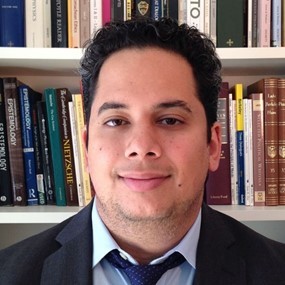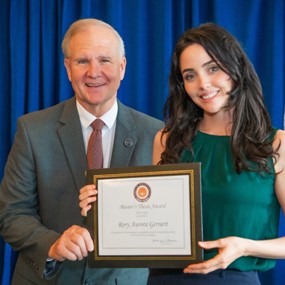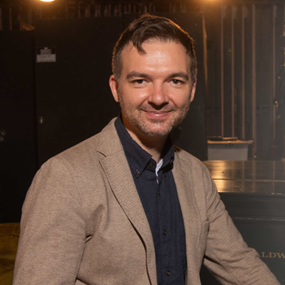'Things You Didn't Know You Didn't Know' about suicide prevention
In this episode of the "Things You Didn't Know You Didn't Know podcast," Assistant Professor of Sociology Tierra James walks us through her work deploying the community readiness model in Northeast Ohio to understand the cause of a rise in suicide rates in the African-American community.
People can call or text 988 or chat 988lifeline.org for themselves or if they are worried about a loved one who may need crisis support.
988 serves as a universal entry point so that no matter where you live in the United States, you can reach a trained crisis counselor who can help.
988 offers 24/7 access to trained crisis counselors who can help people experiencing mental health-related distress.
Transcript
Brandon Etheredge:
When she noticed a rise in suicide rates in Northeastern Ohio, Tierra James knew she had to take action. As a sociologist, she wanted to understand the why behind the issue. She wanted to look at the community, specifically the African-American community in the region. It was hit especially hard by this issue. After lots of listening and analyzing, she's working with community leaders to help solve the issue.
Now, before we start today's podcast, we want to be really clear. We're going to talk about some heavy issues in this podcast. So if you or someone you know is struggling or in crisis or want you to know that help is available, you can call or text 988 at any time to be connected with crisis counselors. You can also chat 988lifeline.org. Visit 988lifeline.org to chat, or call or text 988.
Welcome back to another episode of The Things You Didn't Know You Didn't Know Podcast. As always, I'm your host, Brandon Etheredge and joining me today is Dr. Tierra James, an assistant professor of Sociology at Auburn University. Thank you for joining me today. And let's jump right in. Give me the basics here. What exactly were you looking at with this project?
Tierra James:
So the project that I worked on, we were exploring the Black community of Northeast Ohio, particularly because we saw that in Ohio and with Black individuals, we saw the recent rise in suicide rates. So where they once were sort of protected, as we would say, from suicide, we started to see the rise of that and rise of it comparably to their white counterparts. So essentially from that, we went and we went around into the community of Northeast Ohio to around Akron, these different counties, and essentially did a community readiness project to see, "Okay, is a community ready to address this issue? Do they have knowledge about this issue? And what sort of barriers might exist?"
Brandon Etheredge:
That is such important work. And after your work on the ground in the region, were you able to see what exactly was causing this rise compared to other groups?
Tierra James:
Yeah. So one of the things that we found was that, one, there was a lot of things going on in the world. So in addition to things such as COVID, we also see that community members expressed how they were dealing with things such as poverty, increases in crime, health disparities, a lot of all these different factors in addition to the fact that people in the community just really didn't talk about mental health, suicide ideation in the same ways in which other communities do. And so what we found in our study was that people in the community, the Black people were saying that, "Hey, we just don't talk about it," or "We have all these other issues going on, and so we don't talk about our mental health the same way that we might talk about our physical health," for example.
Brandon Etheredge:
So I know you collected a lot of data in this project. What new information were you able to gather from this study?
Tierra James:
So from the participants and from what we learned, we saw that the community generally has a vague awareness of suicide. So they have an awareness that suicide is an issue. They have an awareness that the effects of suicide on the individual and on their individual's community and family. But we also observe that there is a stigma around it. So particularly our participants had mentioned that suicide was seen as something as though the person was weak. So if you knew someone that committed suicide, they would be looked at as being weak to others. Or we also saw that people had mentioned that if someone was dealing with a mental health crises, they would kind of keep it on the hush or kind of blow it off in a way or ignore it in a way that once that person does attempt suicide or commit suicide, then they kind of realize how serious of a mental health condition it was.
And so we also found that in addition to kind of going back to what I mentioned earlier, we had also seen that people mentioned that, "Hey, there is an issue of suicide, or we believe that there might be an issue," but they also mentioned that there's so many other things going on within the Black community that need to be addressed first. So whether it is that people were living in undesirable housing conditions, poverty conditions, racism is a thing, crime rate, things like that, basically just saying that there were other more serious issues as compared to what they believed suicide was at that time.
Brandon Etheredge:
So I want to get really tactical for a moment. What from this study will you be able to use to help this community solve some of the issues leading to the rise in suicide rates?
Tierra James:
Yeah. So main takeaways really is, so when we went through with our community readiness model, we addressed or we seek to try and address not only how much knowledge they have around the issue, but also what things are currently going on in that community if people have knowledge about those current efforts. And then also we gauged the sort of involvement of leadership and then resources as well. And so from this project, we really are hoping that this gets into the hands of professionals, community leaders and workers in that particular community so that they understand what barriers there might be to addressing this issue and see that there are resources available. So there are resources available to help with mental health, but people need to be more aware of those.
And so that's where we kind of have been going from there in terms of, now that we know what or where the community is in terms of readiness to address this issue, how can we now take those next steps to maybe make people more knowledgeable about the issue or make them more knowledgeable about efforts in their community or make the leaders more knowledgeable about the efforts?
Brandon Etheredge:
Dr. James, how exactly are you and your research team going to educate around this issue for this community?
Tierra James:
Yeah, so with this project, so this was a quantitative portion of it. We've also done a qualitative where we could just take parts of those interviews that people gave us those testimonials. And with all of that, we've been putting together presentations, we've been going to conferences, local conferences around in the region and the area to really present that information and ensuring that scholars know about this and scholars are aware of this issue. And then our next steps are to really go back down into the community, go back more into these local community functions in order to, again, "We have this presentation. We have the knowledge of where we are starting at. And from where we're starting, here's what needs to be done."
Brandon Etheredge:
Well, let's look to the future now, what comes next? Where do we go from here?
Tierra James:
Going from here, definitely disseminating the knowledge that we have. That's probably going to be the biggest thing. Now, it's just disseminating that knowledge and disseminating what is it that is going on, letting people know about the different resources that are available. So that has also been another portion of this project of we've been told and we've looked up and we've researched what is available, what is being done in that community. Now we also need to just put that in a pamphlet and put that out to the people. And so that is one thing that is a big thing. It's just disseminating this knowledge.
And also I think really moving and making the headway on just addressing the issue. I think that from what the participants had mentioned, they had brought up very good points that there's a lot of different things that are going on within the Black community of Northeast Ohio, and I think that mental health is one of those things that also needs to be addressed in addition to the things that you can visibly see such as a crime or impoverished areas. But I think we also need to address just sort of the mental capacity or the mental overload that dealing with those different stressors day in and day out can have on individuals.
Brandon Etheredge:
So one thing that I'm really curious about is how this work might translate to other communities. Is this something where we can say, "Okay, this issue is caused by these things in Northeast Ohio, so we can expect that the same is happening in southwest Ohio or across the Rust Belt or in other areas"? Or is this really more of a snapshot of this one particular community that we really can't generalize outside of that community?
Tierra James:
I mean, that's a good question. So that's something that these findings are going to be very specific to that region. I say that because with the community readiness model, it particularly that community that you want to study. And so I don't know and I can't speak to whether or not these findings would be generalizable to all those other different communities. That would be something that I kind of would just recommend that if you are seeing, scholars are seeing, an increase or a rise in suicide or any other social issue within that community, it might be appropriate to do a community readiness model to see what exactly is happening in that community with those community leaders, with those community resources or lack thereof in order to address that issue at, again, this sort of individual regional basis instead of something, a more generalized approach.
Brandon Etheredge:
So looking at all of this work a little bit more broadly at a field level, how does this work allow for further research or clinical improvements in the area?
Tierra James:
Yeah. So one of the things that we had recommended from this research and from what we had received from our participants was, one, just sort of meeting people where they're at. So meeting community members, meeting this population of people where they're at. So not everyone is going to have access or readily have access to mental health services. And so, meeting people where they're at, whether it is we can't meet you at a hospital or we can't meet you necessarily at a doctor's office, but we know that this community is very religious based, and so we might conduct seminars or conduct mental health checks or wellness checks at a local church function and working with community leaders in that sense to really help tailor those different initiatives to that specific community. Because one of the things that people had mentioned was that they felt as though, especially when suicide as a topic got brought up, they felt as though it was something, as other scholars have noted, a white thing.
So it wasn't something that happened in the Black community. Although we have been seen that historically speaking that it has not been at the same rate as white individuals, however, more recently we've started to see the uptick and the increase of that rate. So it's something that they think that the resources or the programmings or the initiatives are not made for them, but this project is really saying, "Hey, mental health professionals, psychologists, counselors, you have to go and take that step forward to meet those individuals where they're at, that community where it's at because otherwise they might not think to seek out those resources, or they might not have the ability to do so."
I recommend the use of the community readiness model. I think that it is a very helpful model in terms of, again, just seeing where a community is, what is it that they are experiencing, what barriers might be in place, and what is it that they want. Because kind of going back to your earlier question, I think that we can make generalizable recommendations and make recommendations on a larger scale basis, but I think that when you have particularly a minority community, sometimes it might just be best to go in and let the people know that you are seeking out to help them, so you're not coming with any other agenda otherwise to help them. And people were very receptive to us. People we're very receptive to our survey questions and our interviews, and they really were interested in the project that we were doing because really, even in our interviews, there were people that knew someone that was dealing with mental health crisis or someone that had some form of suicide ideation.
Brandon Etheredge:
Dr. James, I want to thank you so much for spending some time to talk with us about this important work that you're doing. To all of our listeners, before you go, make sure you subscribe to the podcast and share it with a friend who might find it interesting. We'll see you next time on The Things You Didn't Know You Didn't Know Podcast.
Speaker 3:
Suicide is a leading cause of preventable death in the United States. Knowing three simple digits, 988, can save a life. If you or someone you know is having thoughts of suicide or experiencing a mental health or substance use crisis, 988 provides connection to free confidential support. There is hope. The Lifeline works. For 24/7 confidential support, just call, text, or chat. 988.






